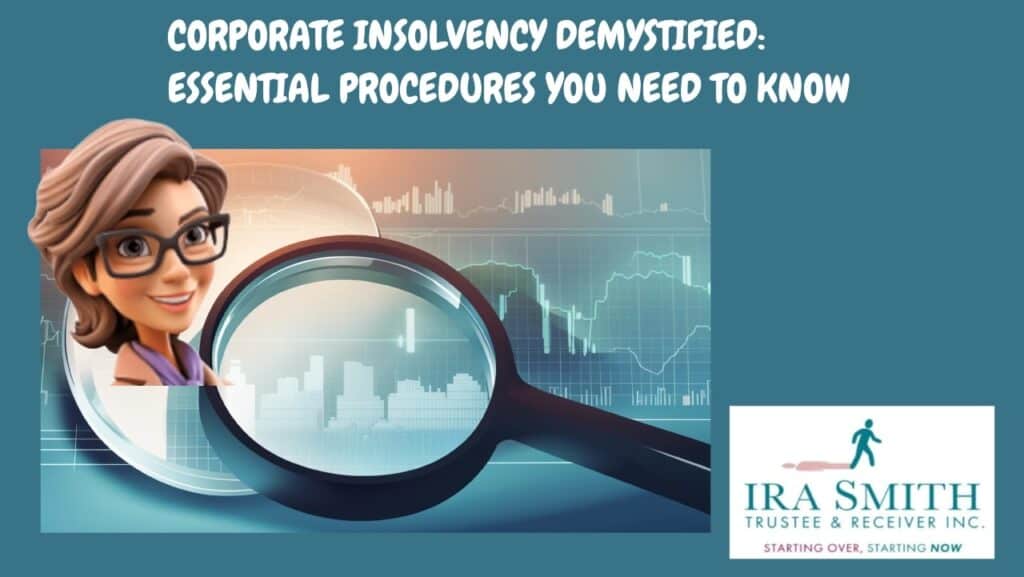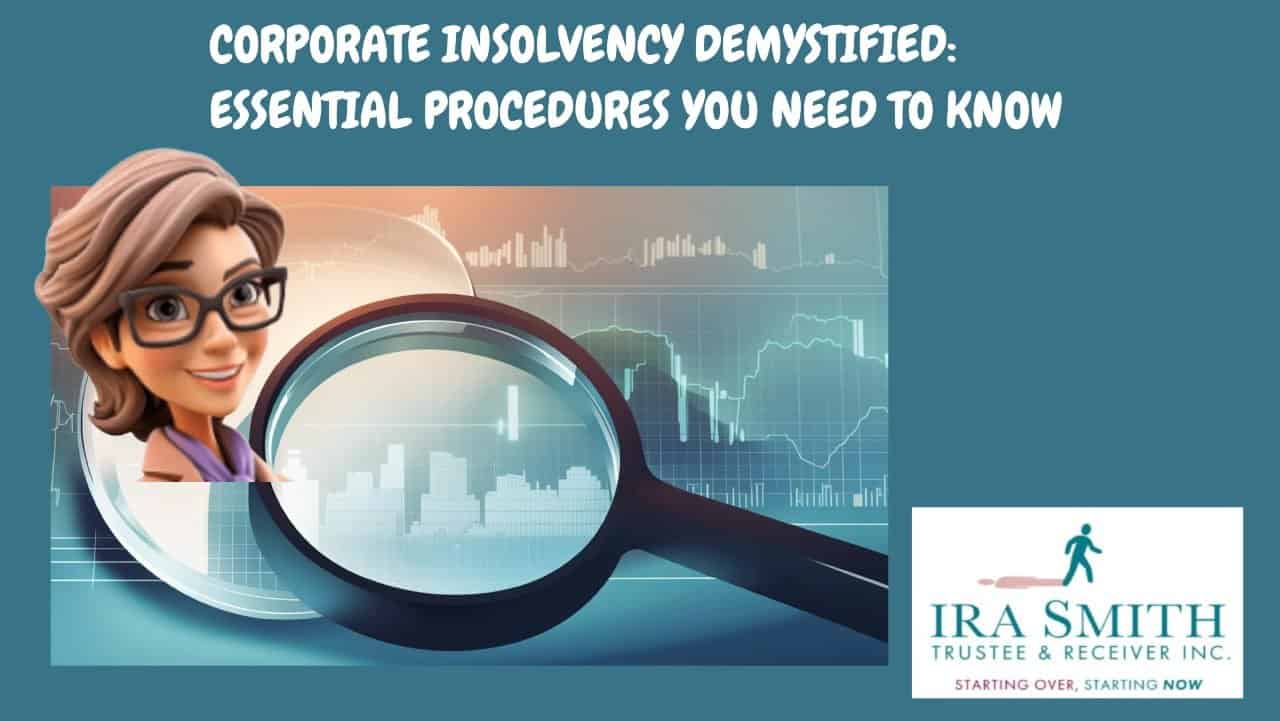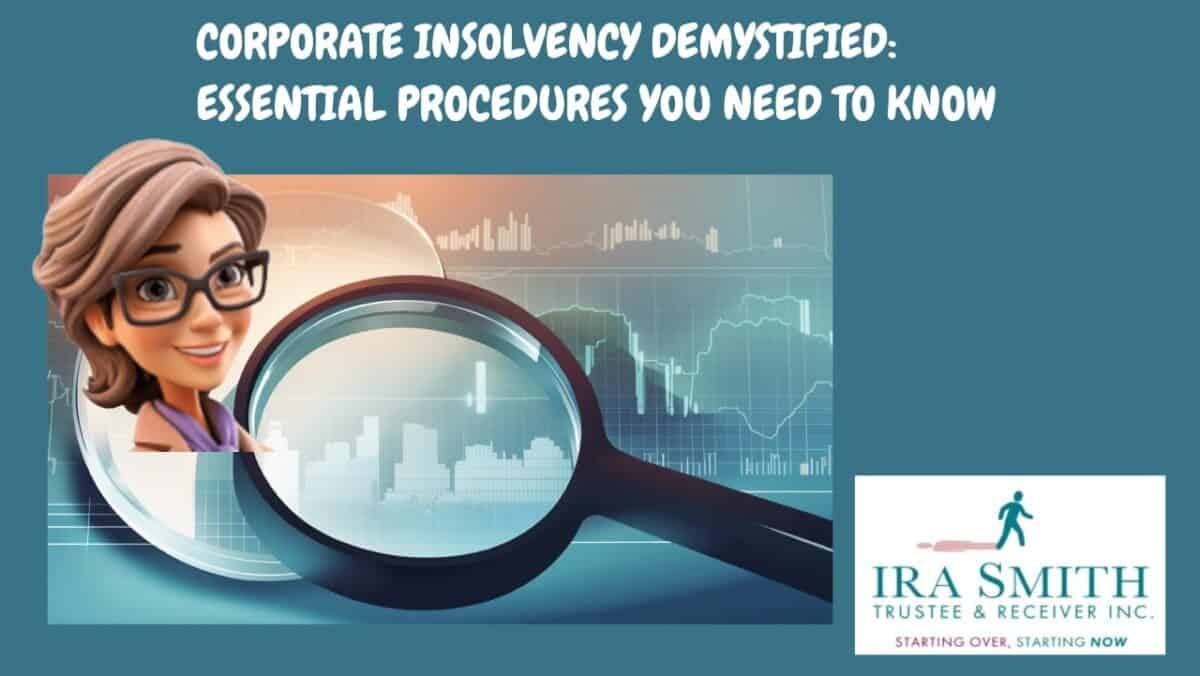Importance of Understanding the Essence of Corporate Insolvency
For the directors and management of a company, corporate insolvency feels like stepping into an intricate maze without a map. As a business owner, navigating financial challenges is far from simple, especially when insolvency starts looming. So, what does corporate insolvency truly mean, and why is it pivotal for us as entrepreneurs to grasp its nuances?
That is the topic of this Brandon’s Blog post. I will break down the crucial steps in corporate insolvency proceedings. We’ll cover everything from spotting early warning signs of an insolvent company like cash flow issues and creditor pressure to navigating formal procedures including appointing a licensed insolvency trustee and making corporate insolvency procedures filings such as formal business restructurings or business bankruptcies.
Definition of Corporate Insolvency and Its Significance
Put simply, corporate insolvency emerges when a business can’t settle its debts as they come due or, notably when the amount of its liabilities surpasses the value of its assets. Think of it as reaching a point where your business’s financial juggernaut feels like it’s sliding down a slippery slope.
The weight of insolvency is staggering. Not only can it culminate in bankruptcy, but it can also lead to severe asset depletion and tarnish the company’s reputation. This situation isn’t just a statistic; it resonates with me as I have witnessed many falter under financial and emotional pressure. Entrepreneurs put their heart, soul, and resources into a venture, only to watch it crumble due to mounting financial strain.

The Implications For Entrepreneurs of Ignoring Corporate Insolvency
Many entrepreneurs can fall prey to the urge to ignore the warning signs. This decision, however, can be catastrophic. Ignoring insolvency can trap businesses in a cycle of debt that feels impossible to escape. Statistics reveal that a staggering 51% of small companies encounter financial distress at some point. This is not just a number; it’s a real-life scenario for many.
“Recognizing insolvency early can be the difference between recovery and closure.”
The consequences go beyond just finances. Picture this: you wake up every day feeling the pressure of creditors, accompanying feelings of stress and fear gripping you tightly. It clouds your judgment, making it difficult to devise a recovery plan. From my observations, it can transform a once-passionate entrepreneur into someone worn and defeated. The psychological impact is immense.
The Psychological Impact of Corporate Insolvency On Entrepreneurs
Entrepreneurs carry the weight of not just their financial obligations but also the hopes and dreams of their employees and communities. To think of potential closure or bankruptcy can feel like a dark cloud looming perpetually over one’s head. Many entrepreneurs, when faced with severe financial challenges, have shared feelings of confusion and despair.
Interestingly, challenges with cash flow emerge as a substantial reason behind many insolvencies, accounting for 82% of failures. I’ve come across several horror stories where businesses, with promising futures, succumbed to the pressure of mismanaged cash flow, all while their owners felt helpless.
Leading Common Danger Signs of Corporate Insolvency
There are many common danger signals of corporate insolvency. The leading ones can be described as:
- Cash Flow Problems: If your business is struggling to meet its financial obligations, it could be a hallmark sign of insolvency.
- Creditor Pressure: The moment creditors start taking legal action, alarm bells should ring; it’s a clear indication that your business is in trouble.
- Declining Performance: A consistent drop in sales and market share can pave the way for financial struggles.
- Debt as a Killer: When a business has gathered a considerable amount of debt that it cannot pay off, it can discover it is challenging to fulfill its economic obligations, which is the leading cause of bankruptcy.
- Declining Sales and Market Share: a decrease in sales can act as a substantial indicator, shedding light on the multifaceted challenges a corporation grapples with.
- Impact of Competition: Are more dominant industry players taking over a larger share of the target market causing a sales decline? The value of the enterprise and its ability to survive must be looked at in comparison to existing competition.
- A problem in Securing Financing: When a company is unable to secure funding, it can be a concerning indication of economic distress. Lenders might consider the company as not creditworthy, implying they do not believe in its capability to pay off borrowed funds.
- Workforce Downsizing and Layoffs: When a corporation finds itself ensnared in economic turmoil, it frequently turns to measures aimed at trimming expenses to reinvigorate its financial solvency. This may entail the reduction of personnel.
When I navigated through some of these struggles with entrepreneurs, I often saw how they failed to recognize these indicators until it was too late. In this intricate dance of financial management, awareness can serve as a life raft.

Corporate Insolvency: The Importance of Regular Financial Reviews
One critical practice that I have learned that entrepreneurs need to prioritize is conducting regular financial reviews. The significance of this cannot be overstated. By scheduling monthly or quarterly check-ins on financial performance, business owners can easily detect irregularities that may signal deeper issues. These reviews ensure that they are not just looking at the surface but diving into the underlying numbers. Analyzing cash flow statements and profit margins helps to understand the business’s pulse.
Moreover, regular reviews provide an opportunity to gather insights on when to cut costs or invest more strategically. In my journey, I’ve found that proactive measures are far more effective than reactive ones. Seeking the advice of financial professionals can also prove beneficial. Engaging with a licensed insolvency trustee or financial advisor can shine a light on areas needing attention and development.
“Timely intervention can save your business from collapsing.”
Reflecting on the insights and advice I have provided to entrepreneurs has further cemented their understanding of why preventive measures are paramount. It’s about more than numbers; it’s about safeguarding the futures of their employees and their families.
Being proactive is critical. Spotting the warning signs early can make all the difference. Whether you face cash flow problems, creditor pressures, or a decline in sales, it’s vital to take actionable steps without delay. Incorporating regular financial reviews into your routine is not just advisable; it’s essential for the long-term viability of your enterprise.
Ignoring these early warning signs can lead to a cascade of financial distress that might have been preventable. Knowledge is power, and armed with the right information, we can steer our businesses safely through turbulent waters.
Taking Initial Steps in Corporate Insolvency
Faced with financial challenges, taking immediate action is crucial – this is where we can regain some measure of control. From my experience, the initial steps can be lifesaving. Here’s what I always recommend:
- Recognize financial distress and seek professional advice: It’s essential to consult with a licensed insolvency practitioner or financial advisor to assess your situation. Seeking help early can prevent a further spiral downward.
- Identify signs of financial trouble and get expert support: It’s important to reach out to a qualified financial advisor or insolvency expert to evaluate your circumstances. Addressing the issue sooner rather than later can help you avoid worsening your situation.
- Perform a Detailed Financial Review: Carefully examine your company’s financial records and current liabilities. Think of this as a triage process; by pinpointing the most pressing issues, you can create a clear and effective recovery strategy.
As I’ve witnessed firsthand, the retainer of an insolvency professional provides a knowledgeable guide in unchartered territory. Our expertise can streamline the process, making sure you’re not navigating blindly.

Corporate Insolvency: A Glimpse into Formal Insolvency Proceedings
Should insolvency become unavoidable and informal processes are not good enough, formal insolvency proceedings may need to be kicked in. It’s an unsettling process, yet understanding it can alleviate some fears:
- Filing for an Insolvency Process: Your licensed insolvency practitioner will make the necessary filing that the company agrees to, be it a restructuring plan, bankruptcy protection or a liquidation bankruptcy filing, with the Office of the Superintendent of Bankruptcy and/or the Court, outlining all the reasons behind the insolvency and the suggested course of action.
- Moratorium Period: The Bankruptcy and Insolvency Act (Canada) and the Court grants this stay period during which creditors can’t pursue legal action – whether it has been started yet or not, which is a much-needed breather!
- Formation of a Creditors’ Committee: The insolvency professional will facilitate communication with creditors, establishing a committee to oversee proceedings. For smaller companies restructuring or liquidating under the Bankruptcy and Insolvency Act, Inspectors can be appointed to oversee the insolvency administration. In a restructuring, the Inspectors can be made up of representatives of both secured creditors and unsecured creditors. In bankruptcy, they are only made up of representatives of unsecured creditors.
These procedures may feel intimidating, yet having a capable team can illuminate the path ahead. It becomes less of a solo journey and more of a united front battling a common challenge.
Corporate Insolvency: Understanding Key Stakeholders and Their Roles
Moreover, it’s essential to recognize the various stakeholders involved in insolvency proceedings. Understanding their roles can help demystify the process:
- Company Directors: They hold a fiduciary duty to act in the best interests of both our company and creditors. It’s a heavy responsibility on company directors, but one that can’t be overlooked. Company directors also have personal liability for certain corporate debt such as unremitted source deductions, unremitted HST and unpaid salary, wages and vacation pay.
- Creditors: The rights of creditors must be respected, and they play a major role in the decisions we make during insolvency proceedings. Ultimately, it is the outcome for creditors that is the measure of whether a restructuring plan, being the alternative to bankruptcy, will be successful or not.
- Employees: A workforce is often directly affected, facing potential layoffs or terminations, adding a layer of emotional strain to an already stressful situation.
- Shareholders: As the value of shares can plummet, communicating transparently with shareholders is essential to mitigate backlash.
As business owners, entrepreneurs have to navigate these intricate relationships, often balancing reputations, responsibilities, and the welfare of everyone involved.
Legal and Regulatory Considerations in Corporate Insolvency
The landscape of insolvency is governed by various pieces of insolvency legislation and other laws and regulations. Understanding them is crucial to making informed decisions:
- Bankruptcy and Insolvency Act: This is a federal statute that details the official processes for managing insolvency, addressing both the financial troubles of businesses and individuals alike.
- Companies’ Creditors Arrangement Act: This pertains to the restructuring alternatives available to large corporations encountering insolvency, specifically targeting entities with debts of $5 million or more.
- Provincial and Territorial Laws: Don’t forget to keep an eye on regional regulations that may impact your situation.
Ignorance of these regulations can complicate matters further, leaving entrepreneurs vulnerable. Hence, diligent research and professional financial advice from a licensed insolvency trustee are vital!
Learning and Recovery from Corporate Insolvency
In the end, while experiencing the fallout of insolvency is distressing, it can also be a valuable learning opportunity. Trust me; I’ve taken away lessons from my encounters:
- Improve Financial Management: Recognizing business financial vulnerabilities can lead us to instill better practices that prevent another fallout.
- Strategies for Prevention: Developing proactive strategies around cash flow and debt circumvents future crises.
- Recovery Opportunities: Embracing restructuring can pave the way for rejuvenation – a new beginning.
Understanding the essence of corporate insolvency empowers us, as business owners, rather than leaving us in a quagmire of despair. The strength lies in recognizing potential pitfalls and arming ourselves with knowledge and professional support!

Taking Action: Your Steps to Recovery From Corporate Insolvency
Winding the roads of entrepreneurship, the terrain gets a bit rocky. Financial distress can feel like a fog that envelops your vision, obscuring the path ahead. But I’ve learned that the moment we recognize the signs of corporate insolvency, immediate action becomes not just a choice, but a necessity. Here are some key aspects that are important to know.
Immediate Actions to Consider
When you first face financial difficulties, taking a moment to pause and assess the situation is crucial. Early warnings might manifest as cash flow problems, where the trickle of income no longer meets the outflow of expenses. Entrepreneurs feel that ominous pressure; it is as if the claims of creditors are a weight pressing down harder. It’s vital to recognize these signs early. If cash flow issues persist, I’d highly recommend consulting a licensed insolvency trustee. This can shed light on your options, offering a clearer view of the landscape.
“The earlier you act, the more options you have to remedy the situation.”
This rings true to me, particularly in my own experiences. Consultation can open doors to opportunities entrepreneurs didn’t know existed. It’s like having a map when you’re lost; it gives you direction. But what else can one do during these trying times? Conducting a thorough financial assessment of your company’s situation is essential. Dive deep into your financial statements, review your cash flow, and outline your debt obligations. This exercise can be eye-opening. I remember analyzing my finances and discovering small leaks – expenses that could be trimmed, and operational costs that could be re-evaluated. Making these assessments can help clarify the path forward.
Seeking Professional Help
In my journey, I’ve come to see professional advice not as a sign of defeat but as a strategic move. A licensed insolvency trustee can be a guiding light, navigating you through the murky waters of corporate insolvency. They provide a fresh perspective and a wealth of experience that can be incredibly beneficial. Think of them as a co-pilot during a storm. Their role involves assessing your business’s financial health and exploring restructuring options with you and providing specific financial advice tailored to your company’s unique situation. With my help as a licensed insolvency trustee, I have helped many companies to restructure their debts, avoid corporate failure and end up flourishing afterward.
Restructuring Options and Their Benefits
As I reflect on the various restructuring options available, one or more of them can be very beneficial. Options like debt consolidation, refinancing, or even asset sales can breathe new life into a struggling venture. I recall a company that opted for a debt restructuring strategy. Post-recovery, they reported a staggering 20% increase in sales! I couldn’t help but marvel at how transformative the right options could be. This solidifies the fact that businesses seeking advice early can improve their survival rates by up to 30%!
When contemplating restructuring, it’s important to weigh the pros and cons of each option. Every choice carries potential outcomes. Debt consolidation may simplify payments, while asset sales could provide immediate liquidity. What I learned was that the potential risks can lead to greater rewards when approached strategically. It’s all about creating a sustainable path forward rather than just reacting to immediate pressures.
Corporate Insolvency Conclusion: Your Journey Ahead
Recognizing financial distress is an unsettling experience. But as I’ve walked through this landscape, I’ve learned that taking action can yield fruitful paths toward recovery. Seeking professional help and evaluating corporate insolvency options is essential because there may very well be a rescue procedure I can take to prevent sinking deeper into distress.
In essence, the journey through insolvency doesn’t have to end in closure. It’s an opportunity for recovery and growth. If you’re facing similar challenges, remember that you are not alone, and by taking proactive steps, you can steer your business toward a brighter future.
I hope you enjoyed this corporate insolvency Brandon’s Blog. Do you or your company have too much debt? Are you or your company in need of financial restructuring due to distressed real estate or other reasons? The financial restructuring process is complex. The Ira Smith Team understands how to do a complex restructuring. However, more importantly, we understand the needs of the entrepreneur or someone with too much personal debt.
You are worried because you are facing significant financial challenges. It is not your fault that you are in this situation. You have been only shown the old ways that do not work anymore. The Ira Smith Team uses new modern ways to get you out of your debt troubles while avoiding bankruptcy. We can get you debt relief freedom.
The stress placed upon you is huge. We understand your pain points. We look at your entire situation and devise a strategy that is as unique as you and your problems; financial and emotional. The way we take the load off of your shoulders and devise a plan, we know that we can help you.
We know that people facing financial problems need a realistic lifeline. There is no “one solution fits all” approach with the Ira Smith Team.
That is why we can develop a restructuring process as unique as the financial problems and pain you are facing. If any of this sounds familiar to you and you are serious about finding a solution, contact the Ira Smith Trustee & Receiver Inc. team today.
Call us now for a free consultation. We will get you or your company back on the road to healthy stress-free operations and recover from the pain points in your life, Starting Over, Starting Now.
The information provided in this Brandon’s Blog is intended for educational purposes only. It is not intended to constitute legal, financial, or professional advice. Readers are encouraged to seek professional advice regarding their specific situations. The content of this Brandon’s Blog should not be relied upon as a substitute for professional guidance or consultation. The author, Ira Smith Trustee & Receiver Inc. as well as any contributors to this Brandon’s Blog, do not assume any liability for any loss or damage resulting from reliance on the information provided herein.






